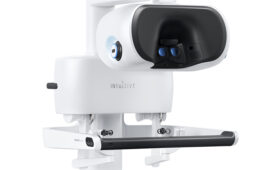Scott Nelson is bullish about technology. The CTO, IoT growth strategist, and owner of Reuleaux Technology believes this is the most fertile environment for technology advances in history. For example, he says genome mapping has far surpassed its initial promise. “I was prepared for insights, but I never expected that it would be able to tell us how a drug or device will work for an individual.”
 Likewise, Nelson says the home healthcare market has surprised him, particularly because his early work dealt with dial-up modems. “I had a bad attitude about home automation, but that is changing too.” In addition to wireless and real-time Internet, 3D manufacturing and sensors are redefining home health: “Every single patient will have a window to the data world, including their health.
Likewise, Nelson says the home healthcare market has surprised him, particularly because his early work dealt with dial-up modems. “I had a bad attitude about home automation, but that is changing too.” In addition to wireless and real-time Internet, 3D manufacturing and sensors are redefining home health: “Every single patient will have a window to the data world, including their health.
But the promise of technology and its ability to impact the market are two different things. Market trends may align or diverge from the abilities of technology.
Nelson says there are a few market trends that designers and engineers should consider:
- Patient as payer
- Fee for value (e.g., bundled payments)
- Home health
- Social networking patients
- Population health
- Patient apps
- DIY health
- Taming chronic care
Technology is not enough, says Nelson. Telemedicine could be an enormous benefit for example. But although 85 percent of people have access to telemedicine, only 2 percent use it, and less than 1 percent use it more than once. Telemedicine companies haven’t been able to offer help or scaling compensation for providers. “The effect is a lack of connection between patients and physicians.”
To assess how much technology matters, Nelson ascribes to a Ven diagram that links design, feasibility, and viability. Analyzing products based on those three attributes can help predict market success. Companies should strive to solve a problem, be effective, and be accountable. The reality is, he says, only products that matter will be adopted. “When you have adoption, it begins a cycle that leads to use, outcomes, feedback, and sharing—which starts the cycle over.”
He describes a product called Whisper, a digital stethoscope used to diagnose bovine respiratory disease. The device digitally reads the animal and delivers a number. Veterinarians found it valuable, even beyond the initial intention. One significant praise came from a vet who said the Whisper “gives him the courage not to treat,” when the use of antibiotics is a sensitive issue. A design detail that surprised Nelson was that in early testing, they learned that the stethoscopes would need earbuds. “The technology doesn’t require ear buds, but a source told us vets wouldn’t use the devices without them.”
Changing design to change behavior
And when it comes to focus, Nelson says each stakeholder has varying motivations, and that designers should strive to understand what drives them. Providers need meaningful data, actionable information, and patient compliance. Payers want low cost, low risk, meaningful data, and patient engagement. Patients want to feel better, they want the process to be easy, low cost, and to integrate family and friends. The common denominator here is the patient. For that reason, Nelson says businesses should adopt a B to B to C strategy.
To better understand patients, Nelson advises both engineers and designers to learn about behavior design. BJ Fogg, he says, has developed a useful behavior model emphasizing that behavior change requires time, intensity, and individual drive. There are triggers that vary by individual and can take place over time. Patients want small easy steps, for example. But Nelson also notes that meeting patient needs and changing behaviors is hard and it only gets harder as time goes on. Further, people are unreliable; they lie to themselves and to others about behavior, e.g., to their doctors.
So what do you do when you can’t trust the reporter? “Fitbit is the most valuable medical device on the market, even if you take accuracy out of the picture because it provides accountability.” He notes there are over 200 studies involving activity trackers ongoing because of the unprecedented data, but more importantly, because of the accountability they provide.
On the development side, Nelson says digital health designers have had to learn to be comfortable with imperfect functionality. “If the product matters, the functionality will come,” Nelson says.
Nelson also advises building a development team with both breadth and depth. “Teams need to develop and react so they can agree on a clear problem, nominate system leads that understand design and work with designers that understand the technology,” he says.

![A photo of the Medtronic GI Genius ColonPro polyp detection system flagging a potential sign of colon cancer during a colonoscopy. [Photo courtesy of Medtronic]](https://www.medicaldesignandoutsourcing.com/wp-content/uploads/2024/04/Medtronic-GI-Genius-doctors-268x170.jpg)


